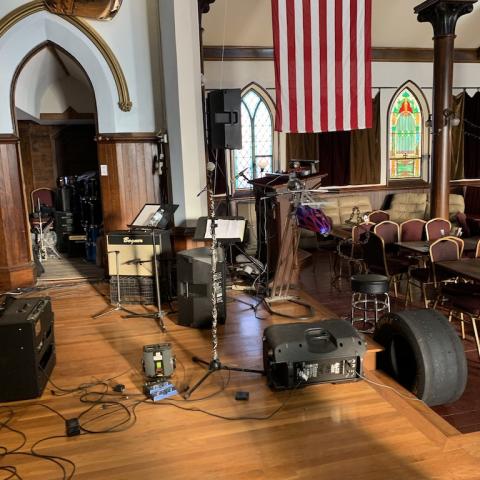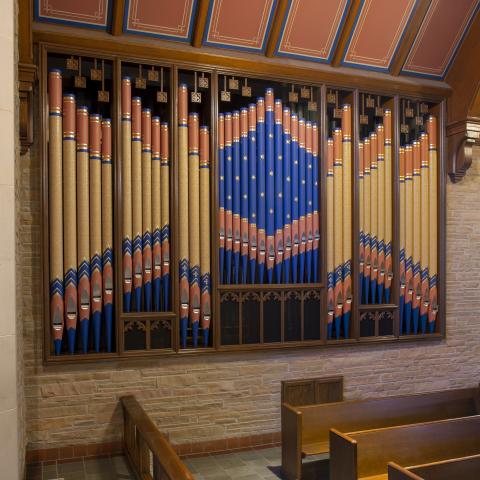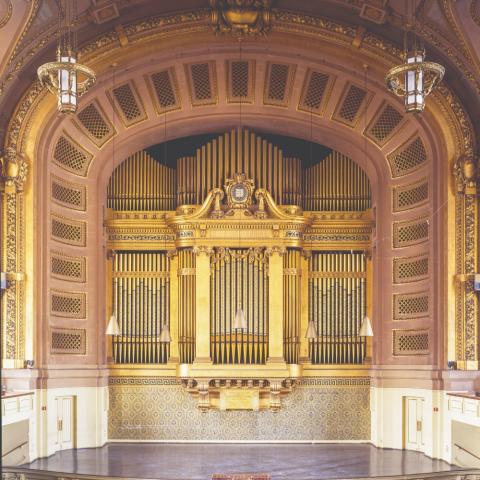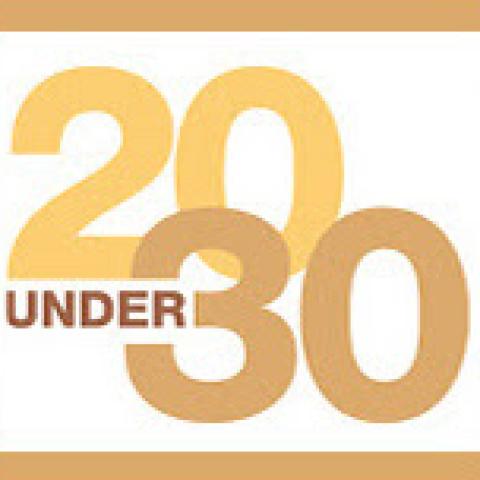American Organ Institute, University of Oklahoma, Norman, Oklahoma
R. Jelani Eddington has been an international theatre organist and concert artist for over thirty years. During his career, he has performed in theatre organ venues throughout the world and has over forty albums to his credit. With degrees from Indiana University and Yale Law School, Jelani Eddington also practices law in Milwaukee, Wisconsin.

A revolution in Norman: how a visionary idea is transforming the organ industry
Many in the organ community have likely heard about the American Organ Institute (AOI) at the University of Oklahoma in Norman. Fewer have had the opportunity to experience the institute first-hand. For many years, I have had the privilege of knowing the faculty and staff of the AOI personally and professionally and am grateful for the chance to share some thoughts about this visionary program.
In December 2017, I spent several days on campus at the AOI and conducted a series of interviews. While I have always held the people at the AOI in the highest of regard, I was nevertheless deeply touched by the fervent passion with which the goals of the institute were shared among all. From the director of the program to students just beginning their musical journey, there was a unanimity of purpose and an understanding that the AOI offers something truly exceptional: the opportunity to be part of a family that, by providing a far-reaching and all-inclusive educational experience to its students, is helping to transform the organ world.
At its core, the AOI is one of the largest and certainly most stylistically diverse organ music programs in the country. Although the institute was founded at the University of Oklahoma in 2006, its bedrock principles began to take shape many years earlier in the mind of Dr. John Schwandt. For too long, he had watched as the various traditions within the organ world operated largely independent of one another. Dr. Schwandt viewed this compartmentalization as tribalism that could threaten the very industry we all seek to promote.
In 2005, Dr. Schwandt, then comfortably ensconced in a faculty position at Indiana University, became aware of a unique opportunity at the University of Oklahoma. The university’s president, David Boren, circulated a letter soliciting applicants to develop an organ program within the school of music, and Dr. Schwandt seized the opportunity.
Among his most important purposes, Dr. Schwandt wanted to unite the often-disparate communities within the organ world. To achieve that goal, the institute would need to offer the rigorous discipline of a traditional organ program, but also offer students the ability to pursue the heretofore unconventional, including concert and symphonic organ playing, theatre organ styling and silent film accompaniment, and organ building and technology.
I asked Dr. Schwandt the obvious question: why was it so important to include all of these various disciplines within a single organ program? Beyond the academic answer, that “knowledge is power,” he had a more immediate and practical response, focusing on providing students a more complete skill set to meet the challenges of being an organist in the twenty-first century. A student who could play a Bach trio sonata flawlessly—but not a hymn—would be ill equipped to serve the liturgical needs of many churches. An organist without basic skills of improvisation would be challenged to segue seamlessly from one musical theme to another or to remedy a situation in which a prepared offertory was 45 seconds too short for the service. And, a student without basic training in the art of theatre organ would surely struggle if asked to accompany a praise band on a Sunday morning. Dr. Schwandt perceived an opportunity to offer a broader spectrum of skills to today’s students, and through the pioneering spirit that is so often associated with the state of Oklahoma, the American Organ Institute was born.
The plans were admittedly ambitious, but, in Dr. Schwandt’s words, “why not?” In 2007, shortly after the AOI opened its doors, the vision of integrating a fully functioning organ shop into the curriculum of the institute became a reality. Shop director John Riester describes the shop as an “education laboratory” with its primary purpose to provide students with projects and opportunities for broad understanding of the mechanical and technical aspects of a pipe organ. This includes work in the shop as well as regular opportunities to work in the surrounding community with service manager Nathan Rau.
The practical knowledge gained at the shop is important because it gives the student a basic understanding of what to do if an organ has a technical problem—whether during a worship service or during a concert or other public presentation. Mr. Riester also emphasized the importance of organists having that basic knowledge in order to be effective advocates on organ committees and to understand how to better understand organ proposals. Importantly, every student at the AOI, regardless of degree program, must spend a certain amount of time in the shop.
The initial funds designated by OU were originally intended to purchase an organ for Sharp Hall of Catlett Music Center. Instead, these funds were utilized over ten years to develop the shop, hire staff, as well as install an organ in Sharp Hall. One of the shop’s first projects was the creation of Mini Mo—the “miniature” core of M. P. Möller Opus 5819. It was procured almost by chance, before its imminent demolition. OU and University of Pennsylvania reached an agreement, and by February 2007 the Möller pipe organ began to arrive in Norman. Completed in 2009, a smaller version was created first so that a working hybrid concert/theatre organ could be used pending the restoration of the complete instrument. AOI students were involved in every aspect of the project, including rebuilding of chests, winding, and installation of the fourteen ranks that now serve as the concert organ for Sharp Hall.
Mini-Mo, an incredibly versatile instrument, complements the more classical C. B. Fisk, Inc., Opus 111, known as the Mildred Andrews Boggess Memorial Organ, in the cathedral-like Gothic Hall of Catlett. Thanks to the work of students and staff at the shop and tireless development efforts by associate director Jeremy Wance, the number of instruments available to students in the program has doubled. With these instruments in the talented hands of the students, a wide range of music is interpreted credibly and, most importantly, musically.
Work at the shop is complemented by degree and course offerings that range from sacred music and classical organ performance to organ technology and theatre organ. While throughout its long history the craft of organbuilding has been passed from generation to generation, often through apprenticeships, no other program exists that offers the credibility and indeed gravitas of a recognized formal degree. The number of organ companies currently in line to hire one of the organ technology graduates from the AOI—37 firms as of February 2019—speaks to the changing nature of the industry and the necessity of this program.
While accredited degree programs existed for theatre organ in the 1920s during the original silent film era, the study of theatre organ has since that time been the nearly exclusive province of private instructors and oral history. In 2016, Clark Wilson joined the faculty to teach theatre organ as part of the curriculum of the AOI. Under his tutelage, students can learn the fundamentals of theatre organ history, playing, as well as silent film accompaniment. And, as with the focus on organ technology, this knowledge has important practical applications, given the growing interest within the larger musical world in theatre organ, orchestral music, and silent film accompaniment.
One of the unique aspects of the program is that it is home to its very own archives and library. In 2012, the AOI acquired the complete archival materials of the American Theatre Organ Society (ATOS), consisting of a treasure trove of materials such as scores, blueprints, stoplists, correspondence, photographs, and recordings. Currently, more than 350 cubic feet of those materials have been carefully preserved, with inventory lists available online.1 The large collection of glass slides from the silent film era has been a particularly fertile area for research.
In addition to the ATOS collection, the archive houses other significant materials that have been donated to the institute, including the Mildred Andrews Boggess collection, the papers of Dr. Larry Smith (including materials from his teachers Arthur Poister and Russell Saunders), and the complete collection of Möller master player rolls. In 2012, Bailey Hoffner became one of the first graduate assistants to work with the collections, and in October of 2016, she returned to serve as the full-time curator and archivist. She projects a discernible passion for outreach and encourages anyone with questions about the materials to contact the archives and library.2 In Ms. Hoffner’s words, “you don’t have to be a researcher” to take advantage of these special collections, and the wide range of research requests, from students in the program to organ enthusiasts from around the world, is testament to that.
Dr. Adam Pajan, instructor of organ and AOI shop technician, described the institute as the “Willy Wonka” of the organ world, offering the ability to explore virtually anything within the greater organ culture. And that very openness is what has attracted so many students to the institute.
In the years since the AOI welcomed its first students, there has been tremendous growth. Since 2006, the number of students has increased from five to twenty-six, with a current count of eighteen majors (four are doctoral candidates) and eight non-majors. Faculty and staff positions have grown to accommodate the students, with the addition of assistant professor of organ, Dr. Damin Spritzer, and three full-time shop staff. Along with that growth has blossomed a shared passion that the vision of the AOI is helping to ensure that future generations have a thriving organ industry within which to practice.
The AOI has its own goals for the future, and two to three times each year the faculty participate in retreats to revise the one-year and five-year strategic plans, always with the aim of ensuring that everything they do is for the betterment of the students. This includes continued expansion and evolution of the curriculum to address the needs of students in the broadest way possible. The AOI shop looks to continue to expand its education of students on the technology of the organ through apprenticeship programs and through pedagogically significant projects. The archive will continue to preserve, catalogue, and strategically digitize as many parts of the collection as possible, not only to protect the material but also to ensure access to those materials for generations to come.
“This industry is not dying,” observed shop manager and instructor of organ technology Fredrick Bahr. “People are coming along with the same passions that we had, and that generations before us had.” The key is to ensure that our educational institutions are equipped to give students the skills they need to thrive in today’s often-changing musical world. That is, indeed, the true vision of the AOI, and I am grateful to have had the opportunity to experience that vision first-hand through the eyes of the students, faculty, and staff.
My visit left me both grateful and inspired. It was clear that the future of the organ industry was in capable hands, both with the talented faculty and staff and exceptional students. But I was also inspired by the talent, camaraderie, and supportive atmosphere that pervaded all aspects of the AOI experience.
In my discussions with the people of the AOI, one word kept coming up repeatedly—family. The students and faculty were passionate in their commitment to the inclusion of everyone within their extended family, and these were not just platitudes offered to an outside observer. To the contrary, the inclusivity, support, and caring was palpable among all of them.
I close by sharing the observations of Dr. Schwandt, whose vision, along with the help and dedication from so many, has created something truly special in Norman. In contemplating what he hopes the legacy of the institute will be, Dr. Schwandt candidly observed:
What I hope we can achieve is to train legions of students who learned how to play music in every way possible, and who learned that they can be greater than they thought. And, I hope that, in whatever way they can have an impact, they leave the world a better place than how they found it. Whether it’s working in an organ shop, playing in a church, teaching, or whatever they may do, I hope they always understand that diligent, hard work will produce excellence. And, excellence will always succeed.
The first squadrons have already left the doors of the AOI and are fulfilling its mission, and many more will follow over the coming years and decades. The diligent, hard work of those who have helped to create and develop the AOI has already paid dividends as seen in the lives and achievements of the students that have been part of the program, as well as the impact the students have had in the industry.
The words of Dr. Schwandt could not ring truer. Excellence will always succeed. It already has, and there is much more to come.
Website: www.ou.edu/aoi.
Interested individuals should contact aoi@ou.edu for more information on audition dates, visits, etc.
The author thanks the University of Oklahoma and the American Organ Institute, as well as the many people who gave of their time and shared of their experiences, including Dr. John Schwandt, Dr. Damin Spritzer, Dr. Adam Pajan, Clark Wilson, Jeremy Wance, John Riester, Fredrick Bahr, Nathan Rau, Bailey Hoffner, and Paul Watkins.
Notes
1. http://www.aoi.ou.edu/aoial (last visited February 10, 2019).







